If you are looking to watch my video on how I implement reader’s notebooks, click below!
Watch the video on Teachers Pay Teachers: Introducing Reader’s Notebooks
Watch the video on You Tube: Introducing Reader’s Notebooks
A couple of weeks ago, I got an email from a third grade teacher about reading workshop and implementing reader’s notebooks during independent reading time. She wanted to know how I get meaningful responses from my readers as they read independently.
She asked:
– How do you introduce, teach and instill in your students to read for 40(or so minutes) and respond to their reading with meaningful responses that really tells you about their reading?
– Do you assign response times or do you teach them to do this well on their own and if so how?
– Do they choose how to respond or again to do you assign them a task?
– Also do you grade these assignments they are working on?
How do you introduce, teach and instill in your students to read for 40 (or so minutes) and respond to their reading with meaningful responses that really tells you about their reading?
At the beginning of the year, my first goal is to get my students EXCITED about reading. We have lots of reading celebrations, such as:
Having our principal come to our classroom to cut the “under construction” tape at the grand opening of our classroom library:
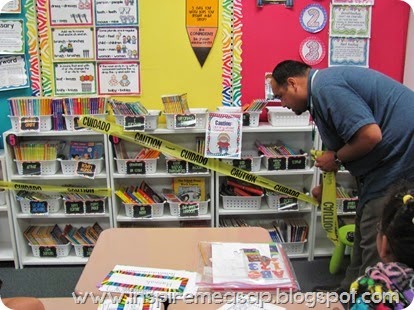
Signing and agreeing to an official “reading workshop contract:”

Learning about the our designated shopping days, to visit the classroom library:

And learning about the classroom library check out system (this is a picture of what I used last year):

The students are PART of the classroom library organizational process, from the first day of the school year. This:


Turns into this:
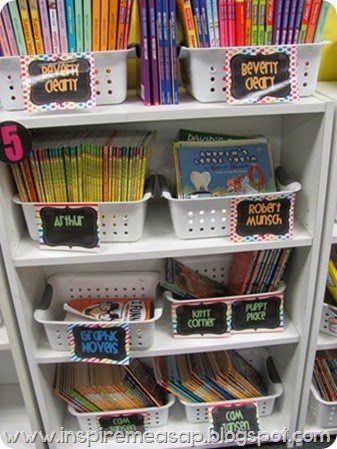

Once the foundation is built, I start to teach my expectations during reading workshop. I begin with the structure of reading workshop: mini-lesson, independent reading, closing.
At the beginning of the year, it is all about building reading stamina. Each class in unique and I have to adjust this every year depending on the students. For most classes, I begin by having my students read independently for about 10-15 minutes. We slowly build up to about 40-45 minutes. As part of my introduction to reading workshop at the beginning of the year, I am *VERY* clear about my expectations during reading time. I find if I do not have these expectations, they simply are not reading.
These expectations make it so that my students will be successful.
The expectation is that during independent reading, the students are:
1. Reading
2. Writing about their reading.
Examples of clear expectations I teach my students from the first week of school:
*There is no moving around the room- when you choose your spot, you are there until the end of reading time.
*If you are distracting other readers, then you will be moved away from them.
Really, that is it! I just “simply” do not allow my students to do anything besides reading and writing during independent time.
And by the way, when I refer to reader’s notebooks throughout this post, I simply mean a composition notebook where students write about what they are thinking during independent reading time.

The reading notebook for this student is on the left hand side of his desk. All of the other materials are keep neat and organized in his personal book nook. (Thanks, Target Dollar Spot!)

Do you assign response times or do you teach them to do this well on their own and if so how?
There are a couple of different types of “responses.” I am guessing this teacher is referring to either a reading response letter or the responses that the students write daily during their independent reading time.
My third grade students used to write reading response letters every week, or every other week, to demonstrate their understanding of the story in our basal. Since my district now uses Benchmark Literacy, I do not use reading response letters anymore as part of an assessment. However, the reading response letters were a really effective way to assess a students reading comprehension of the text, and also their writing/grammar skills. I did grade those every week, using a reading response rubric.
My students now only respond to their reading with their reader’s notebook. Using the structure of reading workshop, my students write in their notebooks as follows:
First, I begin by teaching a comprehension based mini-lesson, such as identifying the theme, making inferences about the main character, writing a summary, identifying the author’s purpose or the author’s point of view. I get the idea for a mini-lesson based on my student’s needs, CCSS, and the mentor text I am currently reading.

At the end of the mini-lesson, I give very specific directions for what the expectation is during their independent reading time.
I might say, “Today when you are independently reading, I want you to…”
Or, “Your job today is to…” Another way, “The expectation is that you…”
As soon as my students go back to their seats, they write down the date and learning target on a fresh, new page in their reader’s notebook. I keep the learning target projected on the Smartboard for the first five-ten minutes, so the students can copy in into their own notebooks. If your students forget to do this part, you can do this as part of the whole class mini-lesson.
For the first couple of minutes of independent reading, I do not meet with any groups. I circle around the room and check in with readers to make sure that they are on track and/or they need help. I then call my first group of readers. Depending on the readers, we may have a different learning target than I introduced in the mini-lesson- that is a whole ‘nother blog post! After my group gets started, I use that time as an opportunity to read their prior responses in their notebook. During the guided reading group, my students write down their thinking in their notebooks and we share what they wrote as part of an authentic conversation to end the lesson.
When I am finished working with one group of readers, I then take another walk around the room and monitor my students. Who needs help? Who has not started to write anything yet? Who needs a reminder?
I then work with another group of readers or conference with students. I often call struggling students to the back table when I am conferencing with individual students. I find that just my presence helps keep them accountable. Smile
My students are not allowed to go to closing unless they completed their writing. They WANT and LOVE to go to closing because they get to talk with their reading partner about what they were reading/what they wrote in their notebooks. If they rushed or did not complete their response, they either work with me at the back table or continue to write more at the end of the day, right before we pack up.
A few pages of a reader’s notebook:



Do they choose how to respond or again to do you assign them a task?
Good question! Both!
If we are trying to identify the theme, I write questions or sentence stem on the Smartboard that help them identify the developing theme of a story. The questions that I put on the Smartboard are guiding the students in their responses.
An example might be:
– What clues do the author give to help you identify the theme? What page number?
I am VERY specific about my questions that I pose. I am not trying to trick my students in any way. I WANT them to use my guiding question and refer to it for their response.
However, yes, there are times when my students can just “write what they are thinking” as they are reading. Prior to this type of lesson, I would have already modeled different sentence stems, which identify traits of good readers.

Do I grade these assignments that they are working on?
Yes, I use the reader’s notebooks as a formative assessment. After I teach a whole class mini-lesson on cause and effect (for example), I can quickly skim each reader’s work to see if they were able to apply the skill with their own book during independent reading time. If they did not meet the target, then I can work that that group of students in a reading group the next day. If a majority of the class, for some reason, does not demonstrate understanding of the skill/strategy, they I would reteach the lesson (using a different text) the next day or two.
My reading workshop time works out so that we have a special right after my students go to closing. I always tell my students to leave their notebooks, “out and open,” so that I can take a quick read of everyone’s work. I do not have my students turn in their reader’s notebooks so that I can “grade them.” I do, however, walk around with my notebook/clipboard and take anecdotal records/notes as I read each notebook. I jot down quick notes about a student who needs additional reinforcement, a student with grammatical errors, or a student who did exceptionally well. I sometimes have that student share their entry with the class the next day, to start our mini-lesson.
I do make sure to leave frequent feedback in each reader’s notebook. Although I would love to write lengthy, detailed feedback for each reader for each lesson- there is just not enough time in the day for that.
Some examples of what I write might include:
– Perfect example of using the text to support your thinking!
OR
– Can you try to use the text to support your thinking?
– You really show me that you understand making inferences with the main character!
– Don’t forget to check your writing for correct grammar!
I try not to write, “great job” or “way to go!” since that does not provide any meaningful feedback.
Another time that I check notebooks is when I meet with readers in a guided reading group. As they are reading their text independently, I take a read through a couple students’ notebooks and provide feedback. I also work with the students in a one/one conference and help build their written work that way.
By taking the time to read through their responses and using the notebooks as a tool during guided reading groups, I have found that this helps keeps kids accountable and write meaningful responses. They KNOW I will be checking/reading their work.
Another example of the books inside this student’s book nook:

You can see the “classroom library check out” form that they glue into their reader’s notebook when the check out a new book from the classroom library.
If you are looking to implement reader’s notebooks as part of your ELA instruction, you might be interested in my resources listed below.
Reader’s Notebook for Reading Workshop
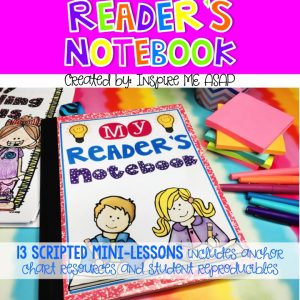
Included in this resource:
– 13 scripted mini-lessons
– Colorful posters to display as anchor charts
– Student reproducibles for every mini-lesson
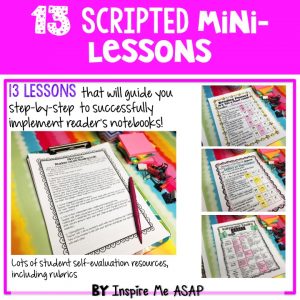
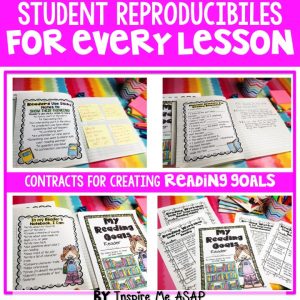
Mini-lessons include:
Readers celebrate their brand new reader’s notebooks with a decorating party.
Readers demonstrate expected behaviors with their reader’s notebooks.
Readers respond to what they read in their notebooks.
Readers use sticky notes to show their thinking
Readers keep a record of their reading.
Readers can respond to a fiction text by writing a response letter.
Readers can respond to a non-fiction text by writing a response letter.
Readers self-reflect on their reader’s notebook by using a rubric.
Readers self-reflect on their independent reading behaviors and habits by using a rubric.
Readers read a variety of different genres.
Readers read with expression and fluency.
Readers have strong reading behaviors and habits.
Readers create reading goals to help them become better readers.
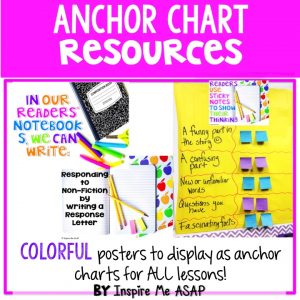
Also included:
* Alternative to purchasing and using composition notebooks for reader’s notebooks.
* Cover pages for reading binders, instead of using composition notebooks. Resources include cover pages (in color and black and white) and directions.
Save 10% by ordering directly from my site!
I hope this post helped explain book nooks, reader’s notebooks, and reading response with you! If you have any other questions, please contact me!




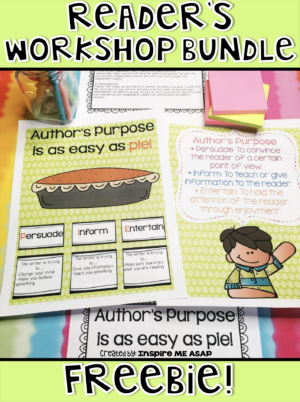





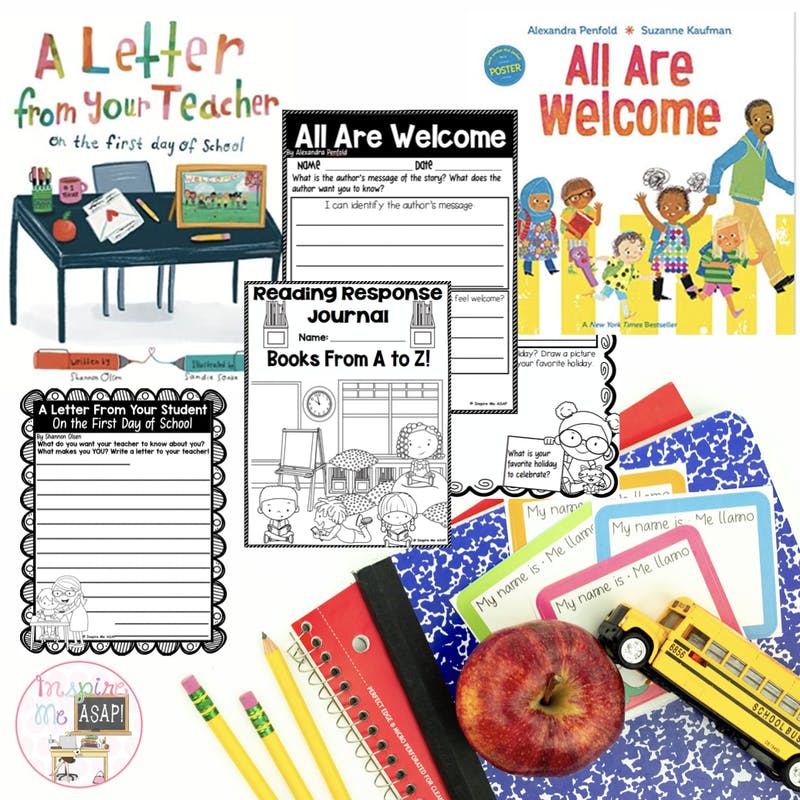
3 Responses
Such an informative post…bookmarked as I know I will want to read it many times over to take in all your points! I truly appreciate how much effort you put into your detailed responses.
Such great info in this post! I'm pinning to remind me to read it again later! Thanks for sharing!
Thank you so much for this informative post. I have printed it out to refer to and I will try it with my new 3rd graders this year! I like the simplicity of the setup of the notebook. It’s simple yet effective at targeting what is taught Thanks again!